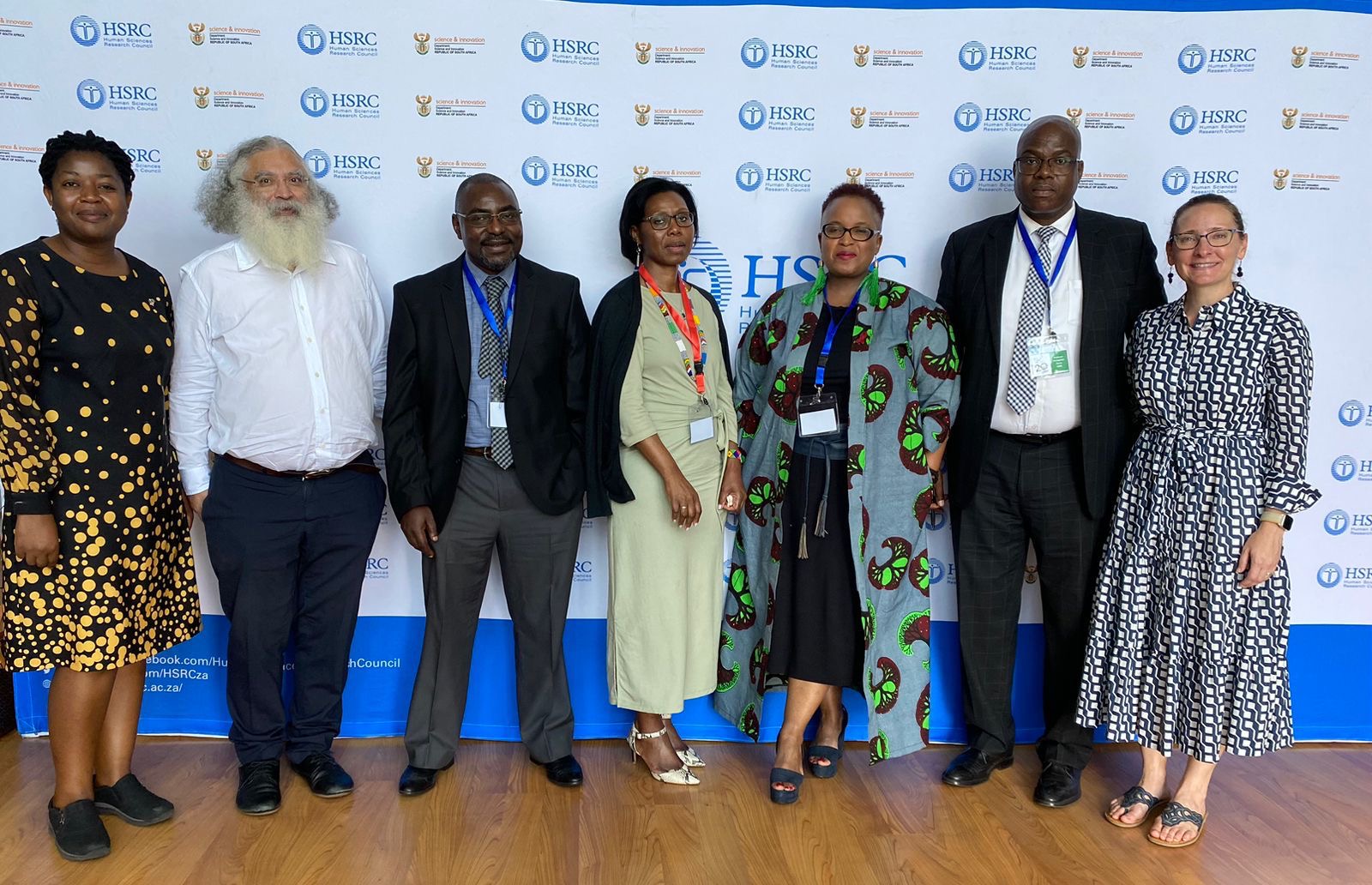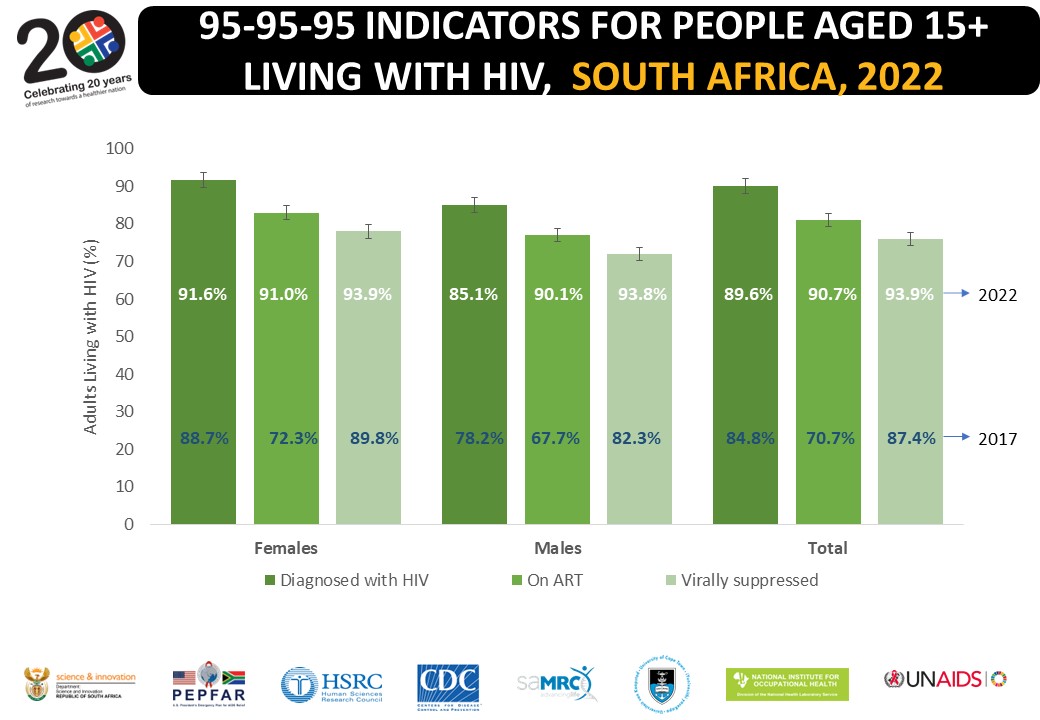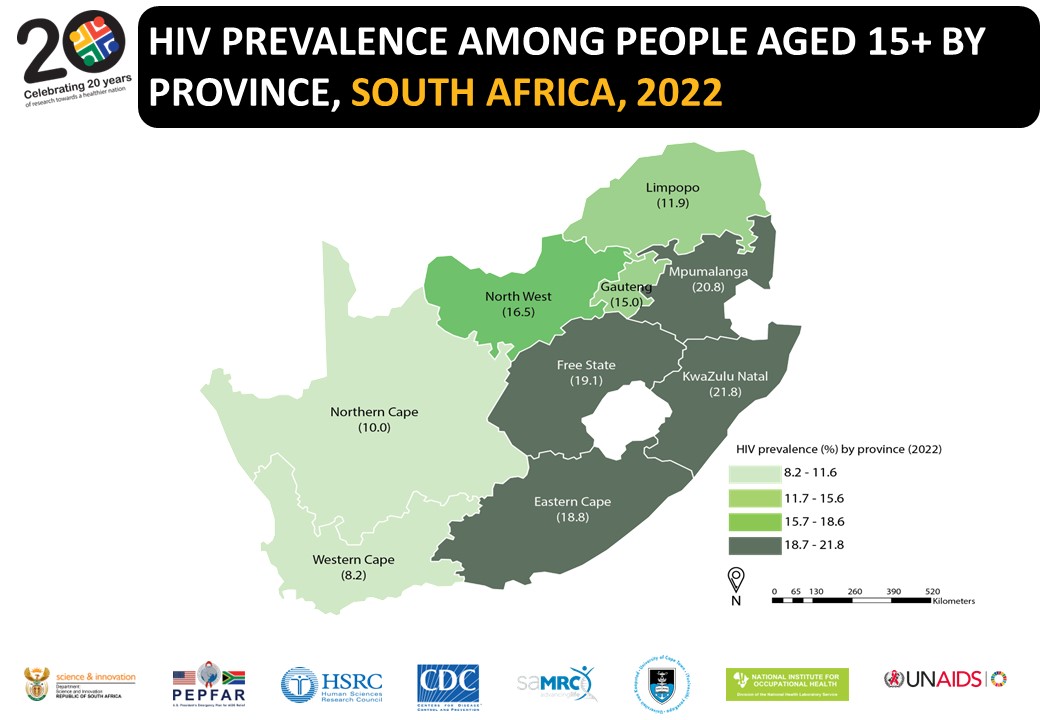The Human Sciences Research Council (HSRC), in collaboration with its partners, today announced key findings from the Sixth South African National HIV Prevalence, Incidence, and Behaviour survey (SABSSM VI), which highlight progress toward ending HIV in South Africa – the country with the world’s largest HIV epidemic.
SABSSM VI found that the percentage of all people living with HIV in South Africa has decreased from 14.0% in 2017to 12.7% in 2022. This translates to approximately 7.8 million people living with HIV in South Africa in 2022 compared to 7.9 million in 2017.
“Several factors contribute to HIV prevalence,” said Professor Khangelani Zuma, Divisional Executive of the Public Health, Societies, and Belonging Division of the HSRC and the overall Principal Investigator of the survey. “These factors include fewer people getting infected with HIV, more children born HIV-negative, AIDS-related mortality, and people aging and dying from natural causes. The increase in the population (birth of HIV-negative babies) would also increase the denominator of HIV-negative people in the country. The epidemic curve also shows an aging population of people living with HIV who are living longer as the epidemic stabilises,” Professor Zuma added.

The 2022 survey shows that South Africa has made significant progress toward the UNAIDS 95-95-95 targets – namely, that by 2025, 95% of all people living with HIV to be aware of their HIV status, 95% of those aware of their status to be on antiretroviral treatment (ART), and 95% of those on ART who also know that that they are living with HIV to achieve viral load suppression. SABSSM VI showed that among people aged 15 years and older living with HIV in South Africa in 2022, 90% were aware of their status, 91% of those aware of their status were on ART, and 94% of those on ART were virally suppressed.
This is an improvement compared to 2017 when the UNAIDS target was 90-90-90 but South Africa achieved 85%-71%-87%. The large uptake of treatment can be attributed to the changes in treatment guidelines in 2016, which made provision for treatment to be given to everyone requiring HIV treatment immediately regardless of their clinical status, which previously needed to include a CD4 count below 500 cells/mm3.

SABSSM VI shows that 81% of people aged 15 years and older living with HIV in South Africa were virally suppressed (less than 1000 copies /mL) in 2022 compared to 62% in 2017. Viral suppression was higher (83%) among women when compared to men (79%) and lower (70%) among younger adults aged 15–24 years. The lowest percentage of viral load suppression (66%) was among men aged 25–34 years old.
According to the survey, half of all young men aged 15–24 years were medically circumcised compared to 43% in 2017. This is an important achievement as studies have shown that male circumcision can reduce the risk of heterosexual HIV transmission by approximately 60%.
The 2022 survey also shows gaps that remain in addressing the HIV epidemic in South Africa. Among people aged 15 years and older, the impact of the HIV epidemic in South Africa is unequal across geographic regions and populations, particularly affecting black Africans, women, and young people. HIV prevalence varied geographically, ranging from 8% in the Western Cape Province to 22% in KwaZulu-Natal Province. Furthermore, HIV prevalence was nearly twice as high among women (20%) compared to men (12%). By race, HIV prevalence was the highest among black Africans (20%), followed by Coloureds (5%), and lowest among Whites and Indian/Asian people (1% each).

“The most pronounced differences in HIV prevalence by sex were seen among younger populations which calls for focused interventions. Compared to males of the same age groups, HIV prevalence was approximately two-fold in females aged 15–19 years (5.6% vs. 3% respectively), and 20–24 years (8% vs. 4% respectively), and three-fold higher in females aged 25–29 (20% vs. 6% respectively),” said Professor Zuma.
“The 2022 South Africa HIV survey documents the remarkable accomplishments of the national HIV response and highlights the gaps and challenges that remain in addressing the disproportionate burden of HIV among populations including women, young people, and black South Africans,” said Dr John Blandford, the US Centers for Disease Control and Prevention (CDC) South Africa Country Director. “CDC South Africa will continue our collaboration with the HSRC and the government of South Africa to respond to these challenges using the survey data to guide our collective efforts to end HIV in South Africa.”
Reflecting on the importance of the survey, the CEO of the South African National AIDS Council (SANAC), Dr Thembisile Xulu said, “SANAC welcomes and endorses the latest of the SABSSM survey, which remains one of the most critical data sources used by SANAC to inform the country’s five-year National Strategic Plan for HIV, TB and STIs. It provides a comprehensive breakdown of the status of the HIV epidemic, thus enabling us to design programmes and interventions that are not only targeted, but also nuanced and geo-specific. We look forward to the launch of the full report in the new year.”
SABSSM VI is a large cross-sectional, population-based household survey conducted from January 2022 to April 2023 to gather information on national and sub-national progress towards control of the HIV epidemic in South Africa. Over the past 20 years, the HSRC has worked with partners including the CDC, the South African Medical Research Council (SAMRC), the University of Cape Town (UCT), and the National Institute for Communicable Diseases (NICD) on behalf of the South African National AIDS Council (SANAC) to implement a series of population-based surveys on HIV. SABSSM VI marks 20 years of the survey series, with the first survey commissioned and funded by former President Nelson Mandela through his Foundation in 2001.
SABSSM VI was conducted in all nine provinces of South Africa among participants aged 0+ years from over 27,000 households on key HIV indicators, social and behavioural factors, and access to medical interventions in South Africa. The study was led by the HSRC and in collaboration with partners and was conducted with funding from the US President’s Emergency Plan for AIDS Relief (PEPFAR) with technical collaboration with the CDC, SAMRC, NICD, UCT, and it was done on behalf of SANAC.
All relevant documents, including the presentation and summary sheet, can be viewed and downloaded here.
Watch the launch proceedings below:


